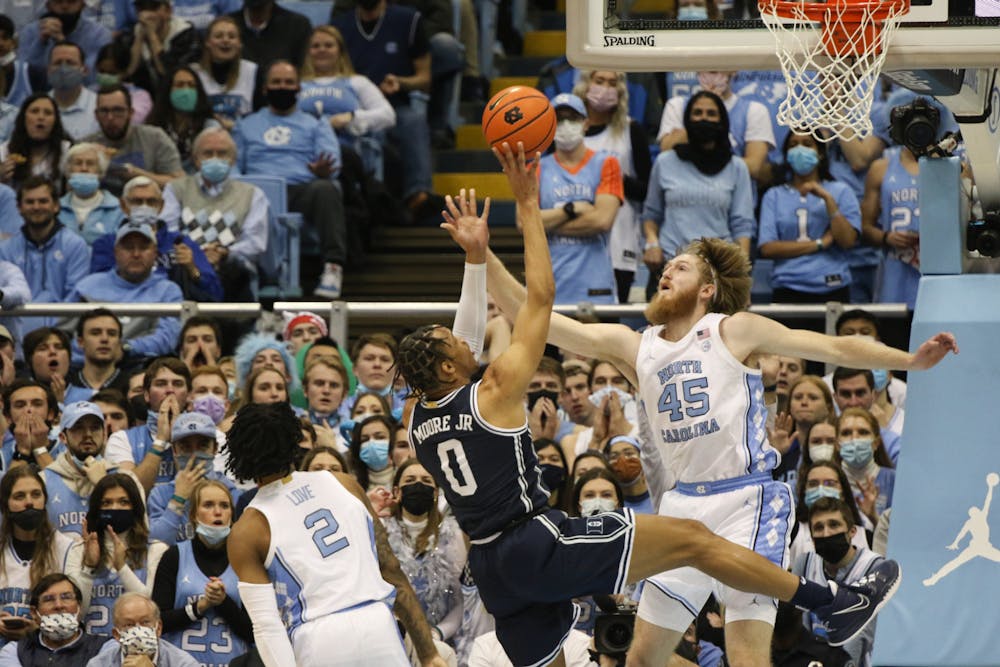Before Duke men's basketball takes on the Cavaliers at home Monday night, the Blue Zone brings three factors that could prove critical for a Blue Devil win:
Virginia’s inconsistency
One thing that makes predicting the key elements of Duke and Virginia’s matchup so difficult is the Cavaliers’ streaky season. They have yet to win more than two games in a row since Nov. 29, and their performance against teams has also been individually inconsistent; for example, Clemson dominated Virginia 67-50 on Dec. 22, but Virginia came out with a 75-65 win in their second meeting just days later.
A particularly intriguing note on the Cavaliers’ record this season is their 71-58 victory over Miami on Saturday, a team with a recent ACC hot streak to whom Duke barely lost in January. This could be a sign that the improvements Virginia has made throughout the season—such as going from averaging 30.2% from the 3-point line in its first 10 games to 37.1% since—may help it remain competitive against higher-caliber ACC teams.
The Cavaliers have won their last two games, so a victory in Cameron Indoor Stadium would end a severe inconsistency streak for Virginia. But given Duke’s defensive and scoring advantages, that may be unlikely for the Cavaliers.
Mark’s match?
Virginia is averaging 4.7 blocks per game, thanks in large part to sophomore forward Kadin Shedrick, who currently ranks third in the ACC with 2.4 blocks per game. But Duke still has the advantage guarding the rim: Duke’s sophomore center Mark Williams leads the ACC with 3.1 blocks per game, and the Blue Devils lead the ACC as a whole with 5.4 blocks per game.
The Cavaliers’ defense relies on their paint protection, as it’s where they get most of their stops and limit other teams’ scoring most effectively. Other teams have found plenty of ways to utilize the weak components of Virginia’s defense; take, for example, North Carolina’s junior forward Armando Bacot putting up 29 points, or N.C. State’s senior forward Jericole Hellems putting up 21 against the Cavaliers.
To maximize scoring opportunities, Duke will need to find other ways to get the ball in the basket from outside the paint. But with the power of freshman star Paolo Banchero and a spectacular weekend from junior forward AJ Griffin, who had 27 points against North Carolina Saturday evening and is averaging 50% from the 3-point line this season, that shouldn’t be a big worry for the Blue Devils.
Slow offense
Virginia’s offensive statistics are relatively weak when compared to the rest of the ACC. The Cavaliers rank second-to-last in the ACC in two categories, with 63.2 points per game and only 51.5 field goal attempts per game.
The slow offense and lack of opportunities at the rim is the primary reason for Virginia’s scoring shortcomings, though it has improved throughout the season to a 45.7% field goal percentage, now sitting at seventh in the ACC. Luckily for the Blue Devils, however, one place Virginia won’t be a particularly dangerous offensive threat from is the 3-point line, only averaging 33.8% from beyond the arc.
Virginia’s leading scorer is transfer senior forward Jayden Gardner with 14.3 points per game, compared to Banchero’s 17.5 points per game. But this statistic may be misleading: if Gardner were a Blue Devil, he’d have the second-highest points per game for Duke, just topping junior forward Wendell Moore Jr.’s 14.2 points per game. With this, Gardner will be the player to guard in Cameron Monday evening, but he’s no more intimidating than the leading offensive foes like Bacot Duke has faced before this season.
Get The Chronicle straight to your inbox
Signup for our weekly newsletter. Cancel at any time.

Leah Boyd is a Pratt senior and a social chair of The Chronicle's 118th volume. She was previously editor-in-chief for Volume 117.

